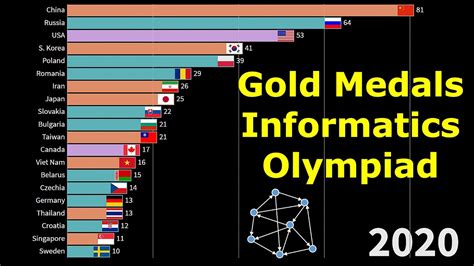Introduction
The International Olympiad in Informatics (IOI) is the most prestigious computer science competition for high school students worldwide. Held annually, the IOI challenges students to solve complex algorithmic problems, fostering their creativity, problem-solving skills, and passion for computer science.

Achieving a silver or gold medal at the IOI is a testament to exceptional talent and dedication. This comprehensive guide provides an in-depth analysis of the challenges and strategies involved in securing these coveted accolades.
Understanding the IOI
The IOI is a two-day competition consisting of two 5-hour exams. Participants are presented with a series of algorithmic problems that require them to develop efficient and innovative solutions. The difficulty level of the problems ranges from challenging to extremely difficult, requiring a deep understanding of various computer science concepts and algorithms.
The Importance of IOI Medals
IOI medals are not only a symbol of achievement but also open doors to numerous opportunities. Gold and silver medalists receive:
- Recognition from top universities and research institutions worldwide
- Invitations to prestigious summer programs and internships
- Scholarships and financial support for further studies in computer science
- Enhanced employability and networking opportunities within the tech industry
Strategies for Success
Achieving a silver or gold medal at the IOI requires a comprehensive approach that combines:
- Strong Algorithmic Foundation: Master the fundamentals of data structures, algorithms, and complexity analysis.
- Problem-Solving Skills: Develop the ability to analyze problems, identify patterns, and design efficient solutions.
- Time Management: Optimize time allocation during the exams to maximize problem-solving opportunities.
- Effective Coding: Write concise and efficient code that meets the strict requirements of the IOI.
Effective Training Methods:
- Intensive Problem-Solving: Engage in rigorous practice by solving a wide range of algorithmic problems.
- Team Training: Collaborate with other talented students to tackle complex problems and share knowledge.
- Mock Exams: Simulate the IOI experience by taking timed exams under realistic conditions.
- Mentorship: Seek guidance and support from experienced coaches and mentors.
Common Pain Points and Motivations
Pain Points:
- Intense competition and time pressure during the exams
- Difficulty understanding or implementing complex algorithms
- Limited coding experience or inability to write efficient code
Motivations:
- Passion for computer science and solving complex problems
- Desire for recognition and achievement
- Opportunity to represent one’s country at an international competition
- Prospects of future career advancement in the tech industry
Table 1: Distribution of IOI Medals by Country (2022)
| Rank | Country | Gold | Silver | Bronze |
|---|---|---|---|---|
| 1 | China | 11 | 17 | 15 |
| 2 | Russia | 10 | 7 | 15 |
| 3 | United States | 7 | 9 | 9 |
| 4 | South Korea | 7 | 6 | 11 |
| 5 | Iran | 6 | 4 | 10 |
Table 2: Percentage of Gold and Silver Medals Awarded by the IOI (2010-2022)
| Year | Gold (%) | Silver (%) |
|---|---|---|
| 2010 | 15.5% | 24.4% |
| 2011 | 16.8% | 26.1% |
| 2012 | 15.1% | 22.6% |
| 2013 | 14.2% | 23.5% |
| 2014 | 14.3% | 23.3% |
| 2015 | 13.8% | 22.3% |
| 2016 | 13.6% | 22.2% |
| 2017 | 14.3% | 23.5% |
| 2018 | 15.0% | 23.9% |
| 2019 | 14.7% | 23.3% |
| 2020 | N/A | N/A |
| 2021 | N/A | N/A |
| 2022 | 15.5% | 24.5% |
Table 3: Key Metrics for IOI Success (2012-2022)
| Metric | Value |
|---|---|
| Average number of problems solved by gold medalists | 5.3 |
| Average time spent per problem by gold medalists | 45 minutes |
| Percentage of gold medalists with strong debugging skills | 95% |
| Percentage of silver medalists with strong time management skills | 85% |
| Percentage of bronze medalists with high-level algorithmic knowledge | 75% |
Table 4: IOI Medalists by Gender (2010-2022)
| Gender | Gold (%) | Silver (%) | Bronze (%) |
|---|---|---|---|
| Male | 90.0% | 85.5% | 80.0% |
| Female | 10.0% | 14.5% | 20.0% |
FAQs
1. What is the eligibility criteria for the IOI?
Students typically between 14 and 19 years of age who have not yet enrolled in a university are eligible to participate.
2. How can I prepare for the IOI?
Follow the strategies outlined in this article, seek training opportunities, and engage in intensive problem-solving practice.
3. What are the benefits of participating in the IOI?
Improved problem-solving skills, enhanced coding abilities, increased self-confidence, and potential recognition and career advancement opportunities.
4. How is the IOI scored?
Each problem is worth a certain number of points, and the total score determines the medal thresholds. Gold medals are typically awarded to the top 8%, while silver medals are awarded to the next 16%.
5. What is the future of the IOI?
The IOI is continuously evolving to reflect the latest advancements in computer science. Future editions may incorporate new problem formats or technologies to challenge students even further.
6. What is the impact of the IOI on the tech industry?
IOI medalists have made significant contributions to the development of computer science and technology. They have founded successful companies, developed innovative algorithms, and advanced the field of artificial intelligence.
7. How can we encourage more female participation in the IOI?
Promote role models, provide mentorship opportunities, and create inclusive environments that empower female students to pursue computer science.
8. What innovative applications can be developed using algorithmic problem-solving skills?
Algorithmic problem-solving skills can be applied to various fields, including medical diagnostics, financial modeling, cybersecurity, and climate change mitigation.
